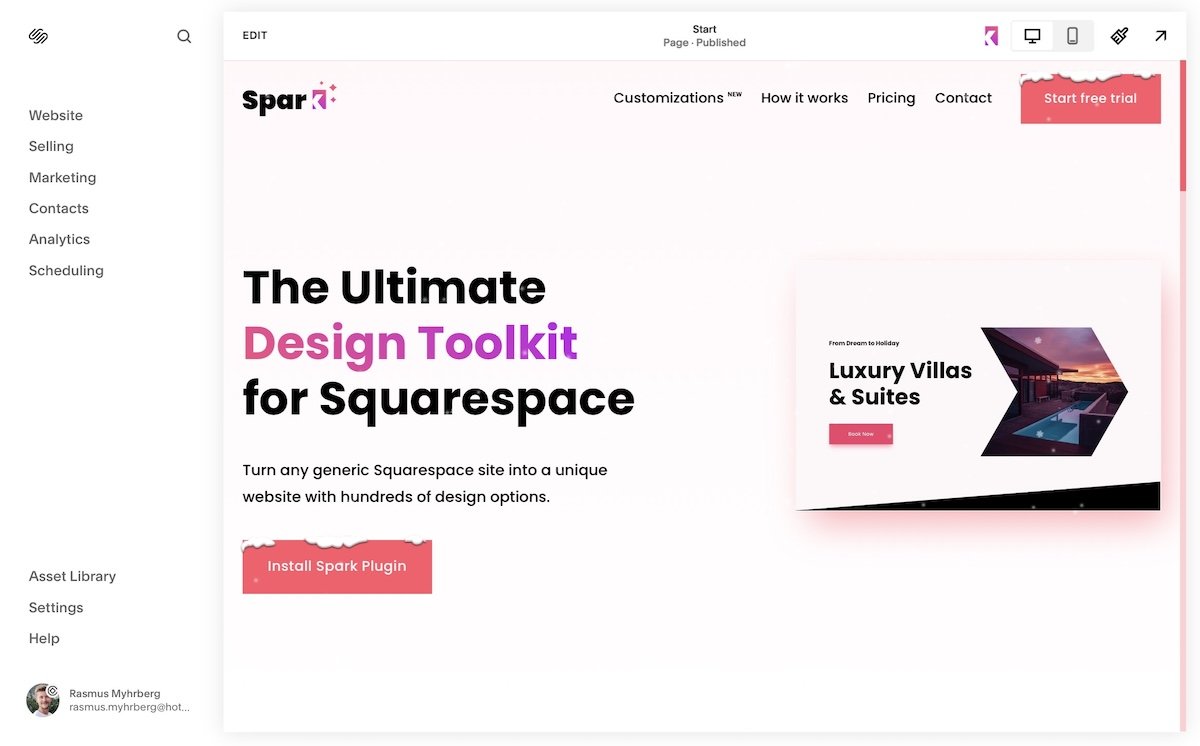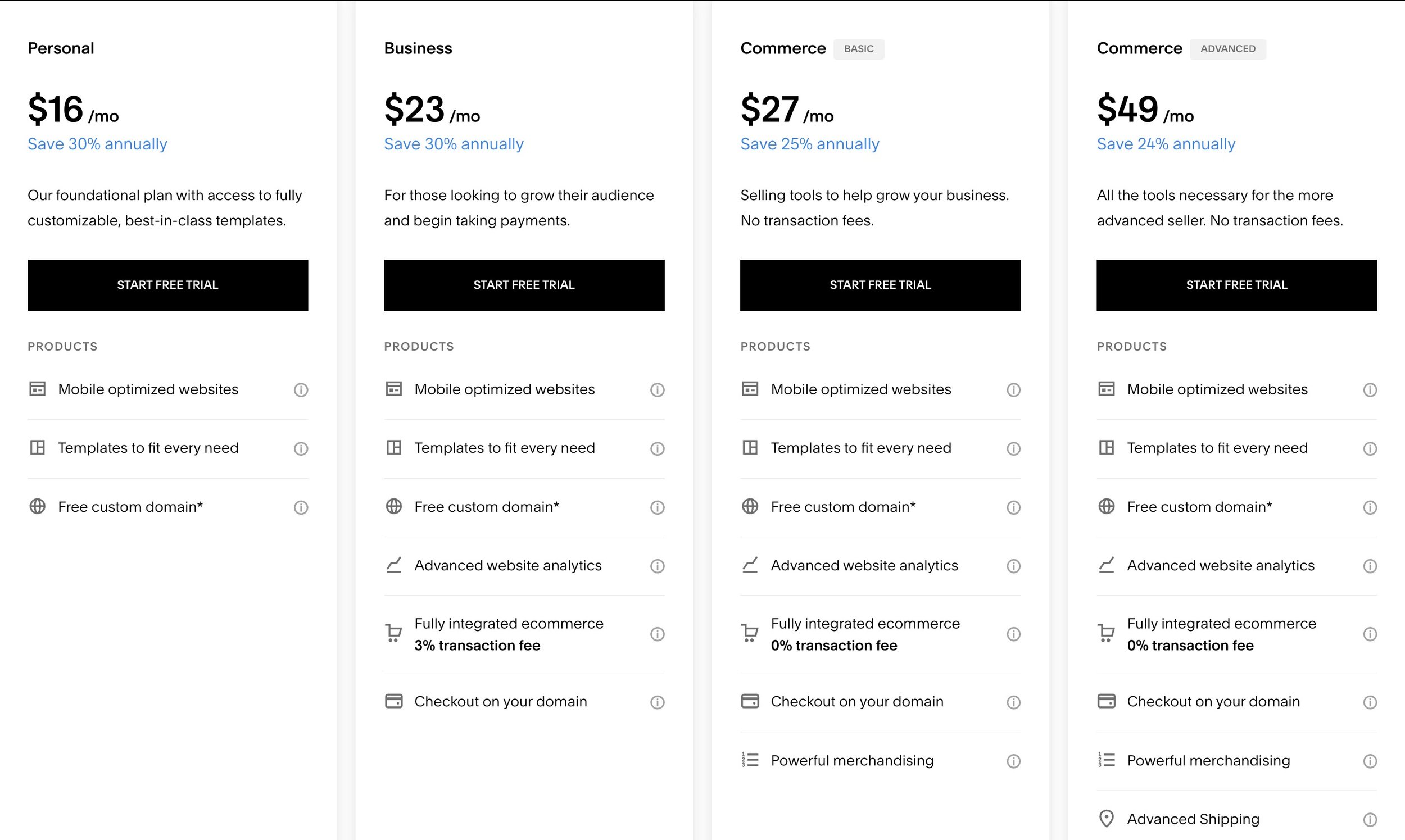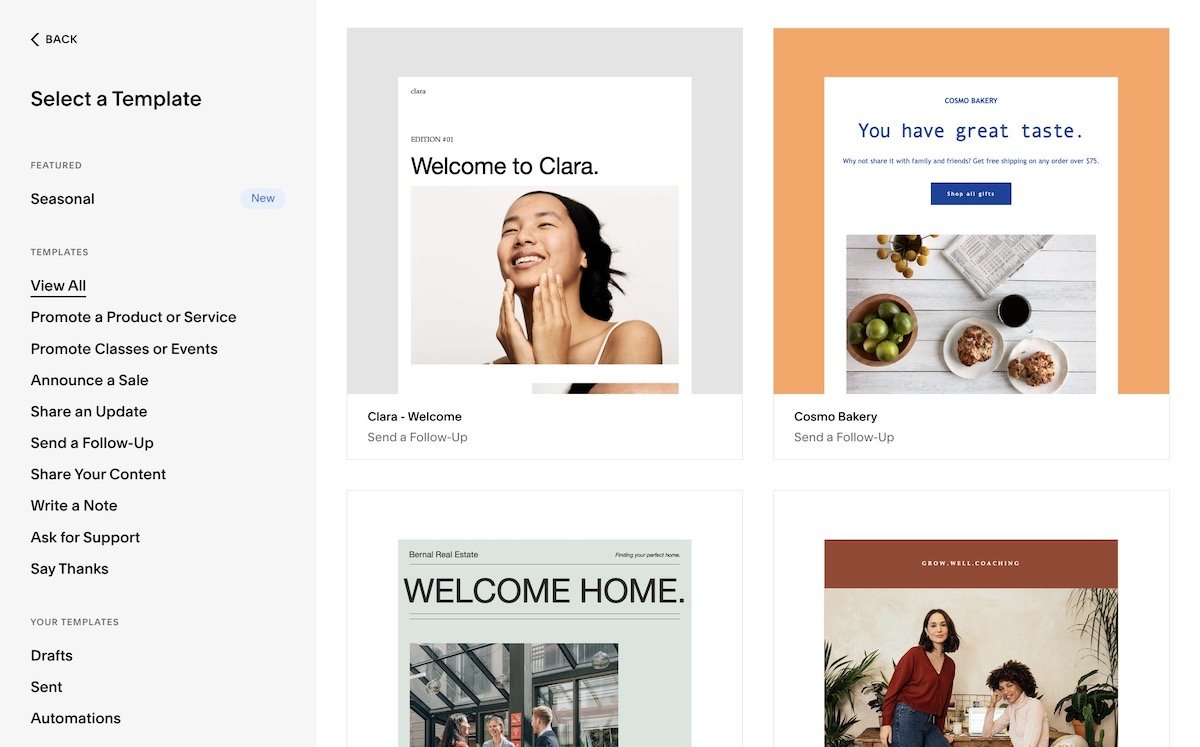Squarespace vs Shopify: 8 Crucial Differences in 2025
Choosing a new website platform can be tricky. It's important to choose one that's affordable, looks good, and has all the features you need to keep your customers happy.
Two popular platforms are Squarespace and Shopify. Both of these platforms are subscription-based. This means you pay a monthly fee, and everything you need to get up and running is included in the cost.
Squarespace and Shopify have more in common than you might think. Both platforms are designed for eCommerce and come with a wealth of additional functionality to customize your website.
However, both platforms have a wide range of differences that set them apart too.
So Squarespace vs Shopify: which wins the eCommerce battle? Let's investigate together.
Want to know more about Wix instead? Check out how Squarespace and Wix compare!
Squarespace is better for beginners
Shopify has more varied pricing tiers
Shopify has more advanced eCommerce features
Squarespace has a longer free trial
Squarespace has more in-built services
Shopify offers point-of-sale
Squarespace is better for content
Squarespace looks nicer
1. Squarespace is better for beginners
Different eCommerce platforms have different learning curves. A platform that's tricky to master might be fine if you operate a large company and have the time and resources to learn about it.
However, if you run a small business, you want something you can jump straight into and start using.
The benefit of Squarespace over Shopify is that it's easier to run with and understand. You're walked through the set-up process, all the different settings are easy to access, and it's extremely tough to break or delete your website – trust me, I've tried!
While Shopify is relatively easy to get to grips with if you have previous website experience, it can be harder to learn if you're entirely new to the world of eCommerce.
Both Squarespace and Shopify offer excellent learning resources and speedy customer service though, so if you get stuck, there'll be someone around to answer all your questions.
2. Shopify has more varied pricing tiers
Squarespace vs Shopify – which is cheaper?
It's hard to say as it depends on what you need.
| Squarespace | Shopify |
|---|---|
| Personal - $16/$23 a month | Starter - $5 a month |
| Business - $23/$33 a month | Basic - $39/$29 a month |
| Basic Commerce - $27/$36 a month | Shopify - $105/$79 a month |
| Advanced Commerce - $49/$65 a month | Advanced - $399/$299 a month |
| Squarespace Enterprise - Quote on request | Shopify Plus - from $2,000 a month |
Squarespace's pricing is a little easier to understand. There are four different pricing tiers:
Personal, which is ideal for bloggers and users that don't need eCommerce functionality
Business for small businesses that want to try selling online
Basic Commerce for small and medium-sized eCommerce stores
Advanced Commerce for larger eCommerce stores
Enterprise for large international companies
Shopify's pricing structure is more complex but offers more variety:
Starter, which is designed for businesses that might not have a website but want to sell through social media
Basic for individuals and small businesses that only sell a small amount of products
Shopify for small and medium businesses that sell more products online
Advanced for large businesses that want to take advantage of lower transaction fees
Shopify Plus for enterprise customers
Shopify also has an additional retail plan for businesses that want to sell in-store – I'll explain this in more detail later in the article.
Each pricing tier on Squarespace and Shopify offers different features and, most importantly, transaction fees. As a rule of thumb for both platforms, the more expensive the plan, the lower the fees you pay per item you sell. It's important to know how many products you want to sell and how the transaction fees will affect how much money you get.
So, which platform and pricing tier is right for you?
It depends on your budget, what you want to sell, and your end goals. I recommend looking at each tier to see what features you need. Both platforms let you upgrade or downgrade your plan at any time.
3. Shopify has more advanced eCommerce features
Ask any digital marketer to name a platform that specializes in eCommerce, and nine times out of ten, they'll say 'Shopify'.
This is with good reason – Shopify has been the market leader in eCommerce for several years. It's no surprise that it's the platform of choice for businesses like Gymshark, Allbirds, and Kylie Cosmetics!
If you're serious about online shopping, Shopify has a range of fantastic features that help you manage your inventory, offer the correct shipping to customers, and sell on other websites like Amazon and social media. Shopify is particularly good if you sell internationally or in brick-and-mortar stores,
Another great feature of Shopify is that you have full access to your website code. This means that if you're a developer, you can make amends to enhance your eCommerce functionality further. While you do have limited access to the code in Squarespace to make aesthetic changes, you can't tweak every line of source code.
While Shopify is fantastic for eCommerce, don't count Squarespace out! The platform is designed for selling online and, over the years, has evolved to offer a wide range of features to help businesses across all industries effortlessly sell their wares. I'll show you some of these cool features soon.
4. Squarespace has a longer free trial
Sometimes, you need a little time to make sure a web platform is not only easy to use but also right for your needs. This makes a free trial extremely valuable.
Both Shopify and Squarespace offer free trials. The Shopify free trial is only three days – not really enough time to test out all the features it has. Although you can usually get your first three months for $1 a month, giving you extra time to build your site.
(Although be sure to cancel your subscription after this time; otherwise you'll have to pay the full amount.)
Squarespace gives you a 14-day free trial, and if you need a little extra time, you can get an additional seven days, no questions asked. However, if you're eligible for Squarespace Circle, you can get a staggering six months to trial your site!
5. Squarespace has more in-built services
Both Squarespace and Shopify have lots of customizable functionality you can use to make carrying out tasks easier and provide additional functionality to customers.
However, the way both platforms provide these services is vastly different.
The bulk of Squarespace's services are offered by Squarespace directly and integrated into the platform, including:
Conversely, Shopify offers extra functionality in the form of apps – there are over 8,000 available! However, many of these apps are provided by third parties, which some users might not be comfortable with from a security perspective.
Too many apps may also have an adverse effect on your page speed, which can affect the user experience.
6. Shopify offers point-of-sale
Do you sell offline as well as online? Point of sale (POS) makes it easy to manage both in-person and online sales in the same place.
With Squarespace, you can do this through Square – however this technology is only available in the US.
Shopify offers two additional tiers for selling in person, meaning you're covered whether you sell at pop-up markets or a brick-and-mortar store – wherever you are in the world. There are also POS devices available for effortlessly taking card payments.
7. Squarespace is better for non-eCommerce content
As Shopify is first and foremost an eCommerce platform, it excels in product pages, category search pages, and checkout functionality.
However, what if you want to complement it with non-eCommerce content, for example, a blog?
The benefit of Squarespace is that it offers lots of supplementary page content, like blogs and portfolio pages. All these have their own templates and are professionally designed. While you can create this content on Shopify, it feels more like an add-on than an integral part of your website.
So, if you want a website without eCommerce functionality, Squarespace is the front-runner!
8. Squarespace looks nicer
This final one is slightly more biased, given that the Spark Plugin website is made in Squarespace! However, I think Squarespace sites are better designed and give you more opportunity to show off your unique style.
Both Shopify and Squarespace offer an extensive range of templates. It's essential to bear in mind here that most of the nicer Shopify templates are paid-for ones. However, in Squarespace, all templates are free and professionally designed.
Here are some of the Spark Plugin team's favorite Squarespace templates.
Another plus point of Squarespace is Fluid Engine, a grid-based system that makes it easy to place text and images exactly where you want them on a page. While Shopify does have its own drag-and-drop website builder, it's not as flexible. As a result, some of the product pages you can create can tend to look a bit samey.
Squarespace and Spark Plugin
And, of course, you can use Spark Plugin to enhance the look and feel of your Squarespace website even more!
Spark Plugin adds over 100 unique customizations to your Squarespace design menu, meaning you can animate call-to-action buttons, transform your navigation bar, enhance your image galleries… the list goes on!
Squarespace vs Shopify: which one should you go for?
Both of these platforms have advantages over the other. However, if I had to distil it down to one key point, it would be simplicity.
The great thing about Shopify is that it's a powerful tool that you can use to create a website with the precise functionality you need to sell to customers. However, it can be hard to master, and you may need specific technical knowledge to take full advantage of everything it offers.
Squarespace might not have as many features, but it's much easier to use. You can get started quickly – just sign up, choose a template, and you're good to go! No coding experience needed, and the drag-and-drop functionality means you can customize your site exactly how you like.
If you want an eCommerce platform with a wide range of features, Shopify could be ideal. However, if you're a small business or new to the world of eCommerce, I'd recommend giving Squarespace a try.
Both platforms have free trials, so why not try both and see which one is right for your needs?
Over to you: Squarespace vs Shopify – which platform is your favorite?
Shopify vs Squarespace: frequently asked questions
Is Squarespace cheaper than Shopify?
This is a tricky question to answer, as both platforms offer a range of pricing tiers with different features. It's better to look at the various features on offer and see which platform and pricing tier is right for your needs.
Can Squarespace be used for eCommerce?
Yes. Squarespace has two plans specifically designed for eCommerce, allowing you to promote your products and sell them online.
Squarespace vs Shopify: which is better for SEO?
Both platforms can help with basic search engine optimization or SEO. You can edit titles and meta descriptions, amend your URL structures, and add contextual alt text to images.
Not only this, but both platforms offer mobile responsive themes, which search engines like Google prioritize. Some of the best Squarespace and Shopify themes are free.
It's important to remember that while both platforms are great for basic SEO, it's still important to do what you can to optimize for the search engines. Solid keyword research, encouraging backlinks from high-quality sites, and optimizing your website for page speed will help.
Google is by far the dominant search engine, with an impressive 87.72% of all searches in the U.S. happening on it. For example, higher education institutions can significantly benefit from the increased visibility of their website in Google searches by employing the proper higher education SEO services."
Is Shopify or Squarespace better for artists?
If your main goal is to showcase your portfolio, Squarespace is the best option.
You can use a template designed for artists, and there are several gallery styles to choose from. Plus, the eCommerce functionality means you can sell your artwork online.
Can you use both Shopify and Squarespace?
Yes! Let's say you want to take advantage of how easy Squarespace is to use, as well as the powerful eCommerce capabilities of Shopify.
You can add a Shopify Buy Button to your Squarespace site for $5 a month, meaning you get the best of both worlds.










